Sweden. Big aircraft of a small country
Sweden has been and remains one of the few countries in the world capable of independently creating first-class aviation technique. Combat aircraft of this Scandinavian country have always been distinguished by some "highlight", you can not confuse them with the same type of aircraft from other countries. In the world there are enough similar planes to each other, but perhaps they cannot be found similar to Swedish fighters. The explanation, in my opinion, is simple: since its inception in the late 1930s, the Swedish aviation industry did not copy already built foreign aircraft, but designed and built its own samples. And the fact that in a short time Scandinavian engineers could not develop (for example, modern jet engines or electronic equipment) was purchased abroad, including licenses for their production.
The result of such a competent technical policy was the fact that in the post-war "jet race" Sweden almost did not yield to the leading world aviation powers, and in some cases even surpassed them.
While France is trying to export Rafale, Sweden is showing the world how a small nation can create its own fighter and even export it.
Saab AB, a Swedish company specializing in aviation, aerospace equipment and military electronics, is the main and, perhaps, the only manufacturer and developer of aviation equipment in Sweden. Based in 1937, the main production and assembly in Linköping, during its existence, developed 13 of various types of fighters and built over 4000 aircraft, most of which met the specific requirements of the Swedish Air Force.
The Swedish policy of armed neutrality influenced the formation of a national aviation industry that did not rely on foreign technology. SAAB has developed all the major combat aircraft that entered service with the Swedish Air Force since the mid 1950-s. Among them are such famous fighters as J32 "Lansen", J35 "Draken" and J37 "Viggen". Currently, Sweden is the smallest country capable of creating modern combat aircraft, which are slightly inferior to similar fighters designed by leading aviation countries.
Post-war story Swedish aircraft industry began with the aircraft J21, or rather with the release of its jet version. The single-seat fighter SAAB-21 is unique in that it was the only aircraft in the world that was produced in a series with both a piston and turbojet engine. Serial production of the SAAB-21 fighter with a piston engine Daimler-Benz 605В power 1475 l. pp., manufactured in Sweden under license from SFA, was launched in 1943 year. It was a plane with a pusher propeller, the use of such a scheme brought the following advantages - better visibility, reinforcement and concentration of weapons in the nose in the form of two 13.2-mm machine guns and two 20-mm guns, plus two more 13.2-mm machine guns in tail beams.
After the end of World War II, it became clear that piston airplanes are becoming a thing of the past and they are being replaced by airplanes with turbojets (turbojet). Naturally, the Swedes did not want to stand aside and began to develop a jet plane. In order not to create a new aircraft for the TRD installation, and it was decided to use the J-21 to install it (to solve a similar problem, did the same at the Yakovlev Design Bureau, setting it to Yak-3 TRD, as a result, received Yak-15).
After short-term use of the J-21R as a fighter, it was decided to use the aircraft only as a ground attack aircraft. The century of J-21A and J-21R aircraft was short-lived, J-21R served only until the middle of 54-th.
The first truly combat, received international recognition, was a jet fighter with swept wing J-29 "Tunnan". Who made the first flight 1 September 1948g. Serially produced in 1950 — 1956 (built 661 machine).
The SAAB designers, unlike others, were able to do without aircraft prototypes, which, as a rule, never entered serial construction. It was much more difficult for Swedish designers to work due to the fact that the theoretical knowledge obtained in the course of continuous expensive experiments in other countries was not available to them or was available, but in a small volume. By the way, the SAAB J-29 was the first serial fighter with an arrow-shaped wing of European design. "Gost" with a centrifugal compressor differed a large diameter. Therefore, Saab 29 (this designation was given to the company project R1001) had to literally sculpt around the engine. It turned out that the fuselage with a small steep nose air intake noticeably thickened to the place where the engine was located and the aircraft was the center of gravity.
For the peculiar outlines of the fighter received the name "Tunnan" (bull, in Swedish). The necessary rigidity of the fuselage and ease of maintenance provided a semi-monocoque fuselage design - a truss with a working skin.
Pilot cabin literally sat astride the engine intake duct. The tail unit was located on a thin tail boom above the exhaust nozzle. The pressurized cabin equipment and ejection seat were borrowed without change from SAAB J-21R.
On one of the serial J-29B, the captain of the Swedish Air Force K. Westerlund 6 in May 1954-th set a world speed record, passing a closed 500-kilometer circle with a speed of 977 km / h and breaking the two-year-old record owned by American North American F-86E ".
The aircraft were in service with combat units until the middle of the 60-x. They installed new radio-electronic equipment on them, and some of the vehicles received air-to-air guided missiles "Sidewinder", which are licensed by the SAAB under the designation Rb.24. The J-29 was replaced by the J-32 "Lansen" and the J-35 "Draken". Fighters, decommissioned, went for scrap, transferred to training units, were used at landfills as ground targets. Quite a lot of cars, especially S-29C, were converted into towing targets. As part of the “wing” of F3 in 1967, a special combat training support unit was formed. The last "Tunnans" flew in its composition until 1975, when they were replaced by J-32D "Lansen". Operation of all modifications of the aircraft "Tunnan" took place almost without incident. The pilots highly appreciated their flight characteristics, good maneuverability and speed of climb, and the staff - convenient maintenance of the device.
J-29 occupies a special place in the history of Swedish aviation: it is the first and only aircraft of the Swedish Air Force that took part in a military conflict outside the country. This happened in the 1961-62 years in the distant African Congo. The main task of the Swedes was to attack the airfields and positions of the rebels. "Tunnans" showed unpretentiousness and high performance characteristics, despite the harsh climatic conditions and constant interruptions in supply.
That J-29B put an end to this war. 12 December 1962. They defeated Tshombe’s residence in Elizabethville, after which the dictator’s government and its guards fled to Rhodesia. The insurgency was crushed, in April the 63-th aircraft returned to Sweden. During the Congolese operation, two J-29Bs were killed due to combat damage and flight accidents. Combat operation once again confirmed the high quality of the first Swedish jet machine - this is the opinion of most of the military from different countries.
The J-29 Tunnan aircraft marked the beginning of another tradition. They became the first Swedish combat aircraft, entered service with the Air Force of a foreign country. In 1960, Austria announced the replacement of obsolete combat-training "Vampires". Following the results of the competition, in which the Soviet MiG-1961F and the American F-17 "Saber" took part, were chosen in 86, J-29F were selected.
The next in the series of combat vehicles was the J-32 Lansen. The first flight of the prototype took place in the autumn of 1952. The plane was piloted by the test pilot of the company, test pilot Bent Olafo (Bengt Olow).
The flight was successful, followed by tests. 25 October 1953, the plane in a gentle dive broke the sound barrier. Soon, all four prototype machines were connected to the tests, parallel preparation of mass production was going on, construction plans were determined. It was supposed to build a car in three main versions: a shock, an all-weather interceptor fighter and a naval reconnaissance aircraft.
In 1955, the first serial J-32A "Lansen" entered service with the Royal Swedish Air Force, thereby initiating the rearmament of attack squadrons to jet technology. In 1955 - 1958, 287 strike aircraft were delivered to the Royal Swedish Air Force.
The strike version of the aircraft was quite powerful armed at the time. Four 20-mm guns "Bofors" M-49 with a total ammunition ammunition located in the forward fuselage. In addition to guns, the pilot "Lansen" also had an impressive arsenal of bomb weapons, including four bombs of the 250 kg caliber or a pair of 500 kg caliber. On the twelve nodes of the external suspension, there could be up to 24 NAR caliber from 120 to 240 mm or two solid fuel robots “Robot” 304 (later designation - Rb 04), the main purpose of which were to be Soviet ships. In general, the UR Rb 04 deserves a separate article, since it is one of the first in the world to have transonic speeds and an active homing head. On it, the Swedish designers are still in the middle of the 1950's. implemented so popular now the principle of "shot and forget." Of course, the firstborn had many flaws (short launch range - 10 - 20 km, poor noise immunity, instability of work on the water surface), but the engineers who created in those years weaponworthy of all respect.
The next variant of the "Lansen" was the all-weather interceptor J-32B, which made the first flight of 7 on January 1957 of the year. Compared with the shock version, this version had a number of significant differences. In addition to the new radar, the fighter was equipped with such innovation as the Sikte 6А weapon control system based on computers. Part of the interceptors was also equipped with the AN / AAR-4 infrared station from Hughes, mounted under the left wing directly in front of the landing gear. The weapons control system displayed information about targets from the radar and the infrared station, as well as navigation information on a monitor screen in the cockpit of the pilot and the operator.
In the 1972, six interceptors were upgraded to target towing vehicles - the J-32D, which were operated up to the 1997 year. More 15 machines, starting with the 1972 year, converted into EW aircraft J-32E. In the nose of the former fighter instead of the radar installed complex G24, designed for jamming ground and ship radar. There were three different station options for the waveband. On the underwing pylons were placed containers of jamming "Adrian" and a container of jamming against aircraft radar "Petrus", as well as two containers with dipole reflectors BOZ-3. The aircraft were used before the 1997 year, including - for the training of personnel of the armed forces of Sweden.
By the end of 1947. the Swedes came to the news that in the United States the experimental aircraft Bell X-1 14 October 1947, overcame the speed of sound. The resulting stimulus forced the SAAB development department to reflect on the design of a supersonic fighter.
It was from that moment that the forms of the new fighter began to emerge, which in the 50s forced us to talk about Sweden as one of the leading aviation powers.
The most difficult moments in the design of the Draken were issues related to the aerodynamics of the wing, its shape and engine, primarily the afterburner design.
The roll-out of the first aircraft (w / 35-1) occurred in the summer of 1955. 25 in October 1955. The plane under the control of Bengt R. Olafo made the first flight. The use of a delta wing with an increased sweep angle in the root parts and a low specific load allowed the Draken plane to land at a speed of 215 km / h, despite the lack of mechanization. For most of the Draken variants, the RM6 engine of various modifications was installed, which was produced under the license of Volvo Flugmotor by the Rolls-Royce Avon engine.
The first pre-production aircraft was called the Draken, and from now on it was referred to as J-35A. Serial production of the aircraft developed to the middle of 1959g.
The aircraft has a data transmission system integrated with the semi-automatic airspace control system STRIL-60, SAAB FH-5 autopilot with the Arenko Electronics air parameters calculator and the SAX S7B sight, modified to allow the use of Rb.27 and Rb.28 rockets. Eriksson PS01 / A radar provides target search and range determination, equipped with a horizon stabilization system.
In addition to it, an Hughes infrared sensor is installed (also installed on the F-102 Convair Delta Dagger), integrated as the radar with the SAX S7B sight. Phillips radar integration system manufactured by PN-594 / A and PN-793 / A. Radio communication equipment includes VHF transceiver p / s produced by AGA Fr.-17 and VHF receiver produced by AGA Fr.-16 (on some planes a Collins receiver was installed) and distance measuring equipment AGA Fr.-15.
The stationary armament of the aircraft consists of two Aden cannons (caliber 30 mm) located in the near wing parts of the wing. In addition, Sidender missiles, Matra containers with Bofors shells, bombs and fuel tanks with a total mass of 3 kg can be hung on the 6 under ventral and 4480 underwing locks.
The aircraft was delivered to Austria, Denmark, Finland and Switzerland, 612 machines were produced in total. The longest operated in Austria, before the start of the 2000's.
By the end of 50-x, it became clear that the Vampire-based UTI on the basis of the De Haviland "Vampire" had served and required replacement. The success of "Draken" led to the development of private initiative designers SAAB model SAAB-105. This is a high-winged swept wing, the seats for two (four) crew members are arranged in a two-row cabin, and two turbojet engines provide traction. An interesting feature of the aircraft is that in the standard version there are two pilots on the spacecraft, but if necessary, spacecraft can be removed and four fixed seats are installed instead.
This aircraft, created as a training one, later became one of the most versatile military aircraft in the world. Experienced TCB SAAB-105 made the first flight 29 June 1963 of the year. It was intended to train both military pilots and pilots of civil airlines. The design of the machine was laid the possibility of rapid transformation into a combat aircraft. In 1964, the Swedish Royal Air Force decided to adopt the aircraft as the main TCB.
In the middle of the 1960-s, on the basis of studying the experience of the Vietnam War, the leading aviation powers of the world increased their interest in light aircraft for direct support of troops. In Sweden, Sk.60A, quickly modified into the Sk.60B strike aircraft, was well suited for this role (six underwing pylons for armament suspension, corresponding wiring, as well as a rifle scope and a cinema shooter) were installed on the machine. The aircraft was designed to support ground forces, as well as the fight against enemy boats and amphibious assault vehicles. In May, 1972 of the year made the first flight of the shock Sk.60G, which has reinforced weapons.
Several aircraft were upgraded to the reconnaissance version of the Sk.60C (the flight of the first vehicle - 18 in January 1967 of the year). A reconnaissance camera was installed in the modified nose section of the fuselage, which has a wedge-shaped glazing, and a tape recorder was installed on board the aircraft to record the results of visual reconnaissance. In total, the Swedish Air Force received the SAN-150 105 aircraft of all modifications, their mass production was discontinued in the 1970 year. 29 April 1967 of the year made the first flight light attack aircraft SAAB-105XT, designed for the Austrian Air Force (the laws of this country at the time forbade flying over its territory supersonic aircraft, therefore, multi-purpose and low-cost SAAB, developing high subsonic speed, met almost all the needs of the Austrian military) . In 1970- 1972 The Austrian Air Force received the 40 SAAB-105TX attack aircraft, which were also used as TCBs, low-altitude interceptors, photo reconnaissance aircraft and target towing vehicles.
The geographical location of the homeland of the Vikings largely determined the "features of the national aircraft industry" in relation to the third generation fighter. The most important requirement of the Swedish Air Force to combat aircraft 1970-90-ies. Ensuring high take-off and landing characteristics — the landscape even of the southern, flat provinces of the country abounded with granite rocks, boulders, and numerous lakes, rivers, and channels, which impeded the construction of field airfields in the classical sense of the word.
The problem of the dispersal of aviation in the event of the outbreak of hostilities could best be solved by creating a large number of standby runways on straight sections of roads (specially reinforced and equipped with side branches for taxiing, organizing technical positions and stands).
The requirement to ensure the operation of motorways played, ultimately, a key role in shaping the appearance of the third generation Swedish jet fighter, which was to replace the fighter-bomber and fighter-interceptor SAAB "Lansen", as well as supersonic fighter "Draken". Required requirements for the third generation fighter were called improved compared with its predecessors, landing characteristics. The Air Force set the condition for bringing the minimum required runway length to 500 m (even for an aircraft with a combat load). In the reloading version of the aircraft had to take off from the strip of normal length.
Before the design of the Draken aircraft began, the military demanded that the aircraft be twice as fast as its predecessor, but at the same time it could be operated from existing airfields. Then a triangular wing with a fracture of the leading edge (with an increased sweep angle in the root parts of the wing) was applied. In the case of the Wiggen aircraft, the task was set to only slightly increase the maximum speed and at the same time the operating condition was introduced from airfields with runways up to 500 m in length.
The "double triangle" configuration was subjected to versatile studies, the purpose of which was to improve the flight performance of the wings at low speeds and to maintain good performance at supersonic flight speeds.
Thus arose the biplan-tandem aerodynamic scheme, in which a large total lift force during take-off and landing is achieved by creating additional lift force on the front wing, equipped with flaps.
To increase this force, the flaps have a boundary layer control system (by blowing it with air drawn from the engine compressor), and the auxiliary wing itself is located much higher than the main wing and has a larger installation angle. Due to this, the angle of attack during landing may be greater than for the Draken aircraft.
The aircraft specialists made a strong (albeit ambiguous) impression on the aviation specialists with their originality and unconventional technical solutions. Its aerodynamic layout was perhaps the most consistent with the "tandem" scheme (although a number of Western analysts called the car a "last biplane"). The AJ-37 had a front, high-placed triangular wing fitted with a flap throughout the span, and a low-lying rear main wing with a triple sweep along the leading edge.
The plane was supposed to have a supersonic flight speed at sea level and a maximum speed corresponding to the 2 Max at the optimum altitude. It was necessary to ensure extremely high acceleration characteristics and rate of climb.
The Viggen was the first Western European combat aircraft equipped with a digital computer that was supposed to provide navigation, gun control, control of fuel production, and control of the pilot’s cockpit information field. For the fighter, a special instrumental landing system TILS was developed, including the onboard and ground parts.
The SAAB 305A air-to-surface guided missiles with a radio command guidance system were considered as the main strike weapons of a promising fighter-bomber. The use of missiles was assumed from low altitudes.
The construction of the first prototype was completed on 24 on November 1966, and for the first time it took to the air 8 in February 1967. It was piloted by SAAB chief engineer Erik Dahlstrom. During the flight test "Wiggen" revealed a number of serious problems associated with the aerodynamics of the aircraft.
In particular, there was a tendency for a sudden pickling during acceleration at supersonic speeds, which was due to the difference in the displacement of shock waves on the upper and lower surfaces of the main wing. This drawback was eliminated due to a slight increase in the cross-sectional area of the fuselage in the upper part, in the area in front of the keel, where a kind of "hump" was formed.
The first flight of the serial aircraft took place on 23 February 1971 g. In 1971, adopted by the Swedish Air Force, where it was used until 2005 year. The serial production of the AJ-37 modification lasted until 1979, 110 aircraft of this type were built.
Initially, the main "intelligent" strike weapons of the new fighter-bomber were three anti-ship missiles, Rb.04E radar homing, suspended under the wing and fuselage, and Rb.XNNXXA radio command guidance (up to two units), capable of hitting RB.05A (up to two units) with radio command guidance (which can be used to hit naval missiles, up to two units), which can hit naval squadrons, up to two units, which can hit naval missiles, up to two units, which can hit a naval vehicle with up to two units. and ground targets. In 1972, Wiggen also received AGM-65 Meyvrik American missiles (made in Sweden under license under the symbol Rb.75) and in Sweden, the new Swedish anti-ship missiles RBS 1988F. For air combat, the aircraft was armed with Rb.15 missiles (licensed AIM-24 Sidewinder).
Mastering the new fighter-bomber (like any fundamentally new combat aircraft) was going quite hard. In 1974-1975 three cars were lost (fortunately, all the pilots piloting them were able to escape). The causes of the accidents were the formation of fatigue cracks in the main spar of the wing of the first 28 serial aircraft in the areas of the fastener hole.
With the 1990-ies, the air force of a number of European countries began to receive a new generation of fighters. They were developed in the 1980-ies to not only reduce dependence on American aircraft export, but also to demonstrate the ability of the European aviation industry to create modern combat aircraft that can compete with American products.
The Swedish company SAAB designed the fighter JAS 39 "Gripen". The program, which led to the appearance of the Gripen fighter, began in the early 1970s, when the Swedish Air Force began to think about the future of its combat aviation. During the 1960-ies in the armed forces of Sweden was restructured, as a result of which the fighter park was significantly reduced. It had to go because of the rising cost of purchasing new aircraft. In 1972, for the first time, the idea of developing a new aircraft designed to replace the AJ 37 Viggen fighter jets, which turned out to be too expensive, and the SAAB 105 training aircraft (TCB), was proposed for the first time.
In March, 1980. The Swedish government reviewed the Air Force proposal, but insisted on an assessment of the likelihood of purchasing Dassault Aviation Mirage 2000 fighters, General Dynamic F-16 Fighting Folcon, McDonnell-Douglas F / A-18A / H Hornet and Northrop F-20 Tyrs, and the Northrop F-5 Tyrs F / A-1950A / H Hornet and Northrop F-1980 Tyrs, and the Northrop F-39 Tyrs F / A-12A / H Hornet and the Northrop F-404 Fighters F / A-404A / H Hornet and the Northrop F-18 Fighters F-39 F / A-1A / H Hornet and Northrop F-1 "(in the F-XNUMXS version). In the end, the government, deciding that the country should create its own aircraft, provided SAAB with the opportunity to continue the tradition of developing fighter jets, made according to the original aerodynamic schemes (tailless or duck), which began in XNUMX. In May XNUMXg. The biennial exploratory studies were approved by the Swedish parliament, and in September of the same year, the IG JAS industrial group (“Industry Group JAS”) was formed as part of SAAB, Volvo Fligmotor, FFV Aerotec and Eriksson firms. After that, SAAB began designing the aircraft and its onboard systems. The choice for the JAS XNUMXA fighter aerodynamic "duck" with a full-turn GIP meant the provision of static instability for high maneuverability. This, in turn, required the use of digital EDSU. As a power plant, they decided to use a single Volvo Flimmotor RMXNUMX, which was a licensed modification of the General Electric engine FXNUMXJ (engines of the FXNUMX family were used on McDonnell-Douglas F / A-XNUMXA / B fighters). The calculated maximum take-off weight of the JAS XNUMXА fighter did not exceed XNUMX XNUMX t.
9 December 1988. The experimental Gripen 39-1, piloted by test pilot Stig Holmström, made its first flight. Prior to this, the pilot had worked on the flight stand over 1000 hours. Already in the first flights, we had to face serious problems associated with the work of the EDS and the features of the statically unstable layout of the aircraft. In the sixth flight (2 February, 1989), the 39-1 fighter crashed while landing at Linköping plant aerodrome.
Test pilot Lara Redestrom managed to remain intact, except for a damaged elbow and small scratches.
The accident caused a long delay in the program to create a fighter. Her investigation showed that self-excited oscillations in pitch due to errors in the software of the control system, aggravated by strong gusts of wind, became the cause.
By the end of 1991g. SAAB announced that all problems with avionics and software have been resolved. In this regard, the Air Force Command decided that the Gripen fighter could be put into service, since during the tests many design characteristics were improved. In June, 1992 was given permission to create a two-seater JAS 38В aircraft. At the same time, a contract was signed between SAAB and FMV for the production of a second batch of fighters. In September, 1992, the two Gripen prototypes, debuted at the aerospace exhibition in Farnborough.
The first fighter JAS 39 "Gripen" of the Swedish Air Force received in November 1994. The deliveries of the Gripen fighter for the Swedish Air Force are divided into three lots (Batch 1, 2, 3). As avionics improved, the newly built aircraft differed in equipment and combat capabilities. All fighters of the first batch were equipped with a triplex digital EDSU produced by the American firm "Lear Astroniks".
Fighters JAS 39C / D "Gripen" third party fully comply with NATO standards, which makes it possible to take part in joint combat operations. The aircraft are equipped with a new identification system, and the pilots received night-vision goggles. There are plans to further improve the aircraft. For example, it is proposed to use the passive IR-OTIS search and tracking system (developed by SAAB Dinamix and resembling a heat finder in a spherical fairing, mounted on Russian fighters in front of the cockpit canopy), and an airborne target designator and on-board radio with AFAR. The armament of the single-seat fighter JAS 39А (or JAS 39С) includes an integrated single-barreled 27-mm Mauser VK27 cannon with 120 ammunition of shells. First, for hitting air targets, the Gripen aircraft could carry a short-range SD with the Rayduon AIM-9L Sidewinder (Rb74) with a thermal homing head, and in the middle of the 1999,
Medium-range AMRAAM AIM-120, which had the designation Rb99 in the Swedish Air Forces, was put into service. It should be noted that the fighter from the very beginning of development was considered as the carrier of AIM-120 missiles; relevant agreements were signed between the governments of the United States and Sweden. The Ericsson Ericsson PS-05 / A radar was designed to use these missiles equipped with an active radar guidance system. The Gripen plane can carry four AIM-120 SDs and simultaneously attack four targets. At the same time, the radar is able to accompany even 10 targets.
For the destruction of ground targets, Hughes AGM-65A / B Meyvrik remotely controlled air defense missiles were used, which had the designation Rb75 ("Rb" - from the word robot) in the Swedish Air Force. The AGM-65B rocket was distinguished by the presence of the target magnification mode, which made it possible to capture the target at a distance two times larger than the AGM-65A rocket did. The weapons include planning cluster munitions VK90 (DWS39 "Mjolner"). The BK90 ammunition is a variant of the German DASA DWS24 cluster munition developed in Sweden, designed to destroy unarmored targets in open areas. The SAAB Dinamix Rbsl5F, developed on the basis of the Rbsl5M rocket, which was in service with high-speed patrol boats, is used against surface targets.
By April 2008g. 199 fighter was built. The 28 of January of the same year during the test flight of the second Gripen fighter, designed for the South African Air Force, overcame the 100000 flight hours for the entire fleet. Total Swedish Air Force ordered 204 fighter JAS 39 "Gripen". If the construction of the first mass-produced JAS 39 aircraft took 604 days, then by the time the first batch was completed, the assembly time of the fighter was reduced to 200 days.
In recent years, the Gripen fighters took part in various NATO exercises in Europe, and in July-August 2006 for the first time took part in the Coope Coop Thunder exercise in Alaska. Five JAS 39C airplanes and two JAS 39D airplanes flew from Sweden to USAF Air Force Eielson (Alaska) for five days, overcoming almost 10200 km along the Scotland-Iceland-Greenland-Canada route. For the first time, Swedish Air Force aircraft took part in exercises outside Europe. In the summer of 2008, four Gripen planes made their debut in the large-scale Red Flag US Air Force exercise at Nellis airbase in Nevada.
The fighter was delivered by the Czech and Hungarian Air Forces (leased by 14 vehicles), South Africa and Thailand are equipped by 26 and 6 fighters, respectively. In addition, these aircraft are delivered to the test school of the British Air Force. The plane participates in competitions in Brazil, India and Switzerland, there are plans to export to Croatia and Denmark.
To date, the Swedish Air Force has more than 330 aircraft.
In their composition there are also airplanes ARLO ASC 890 of its own production, based on the Saab 340. The basis of its equipment is the PS-10 Ericsson Erieye multipurpose radar operating in the 890-cm wavelength range, which has a two-way active phased antenna array (AFAR).
The station, whose operation is controlled from ground points, is capable of detecting more than 100 air and ground (surface) targets. The crew consists of pilots and four operators. 2000 - 6000 m patrol height. According to Swedish experts, the system is capable of detecting and tracking cruise missiles and small targets with an effective reflective surface of less than 1 м2. During the demonstration flights, it provided detection of low-altitude air targets at a distance of up to 400 km, ground and surface targets - up to 300 km. Radar PS-890 Ericsson Erieye can be installed on small aircraft of various types.
The comparison of the Swedish aircraft industry with the aircraft manufacturing industry in France is significant. Sweden has managed to create and equip its air force with its own-developed combat aircraft, which are practically not inferior to the French. For a country with a population of 9 million and a GDP equal to 15% of French, this is not bad at all, especially considering that Sweden is developing other types of weapons, such as submarines, frigates and armored vehicles.
Based on:
http://www.modernarmy.ru/article/63
http://airspot.ru/catalogue/item/saab-aj-37-viggen
http://my.mail.ru/community/miravia/16EBA8A182B41DAC.html
http://www.airwar.ru/enc/fighter/jas39.html
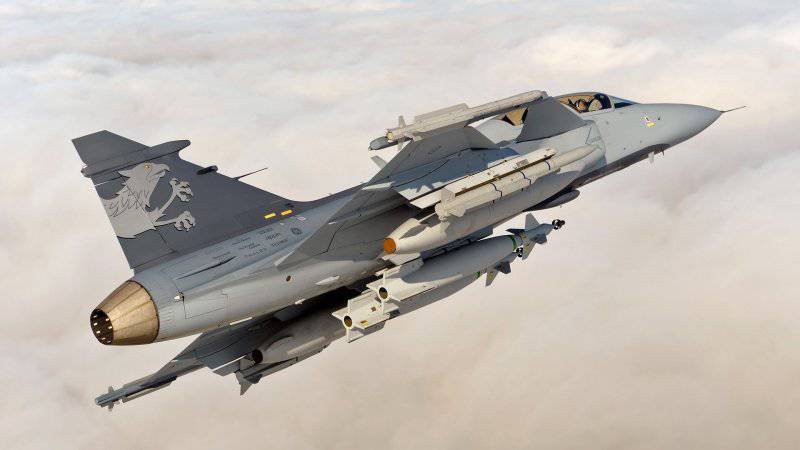
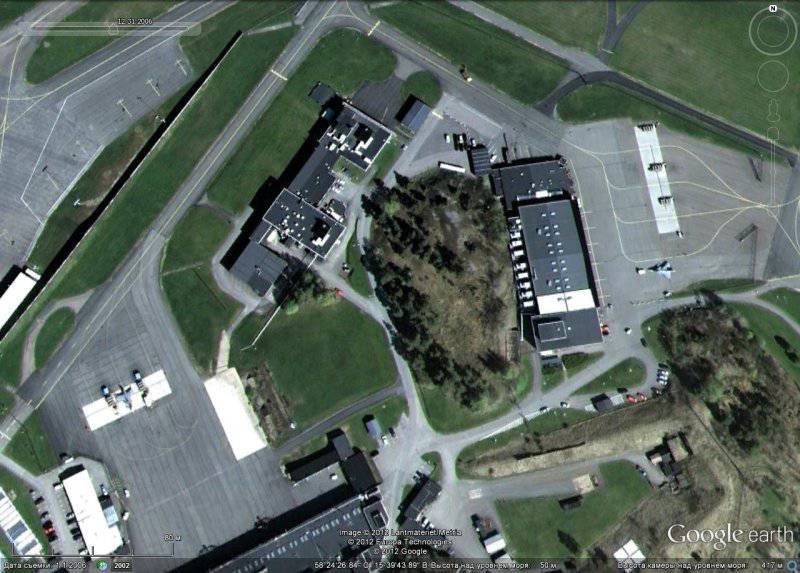
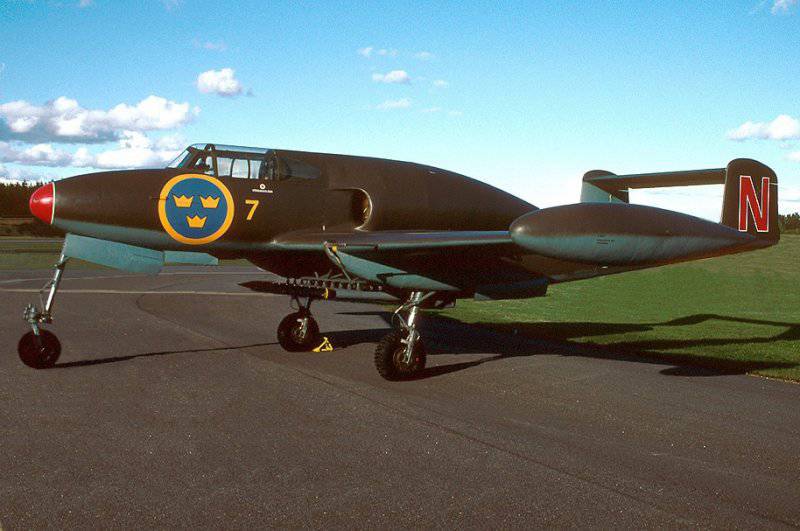
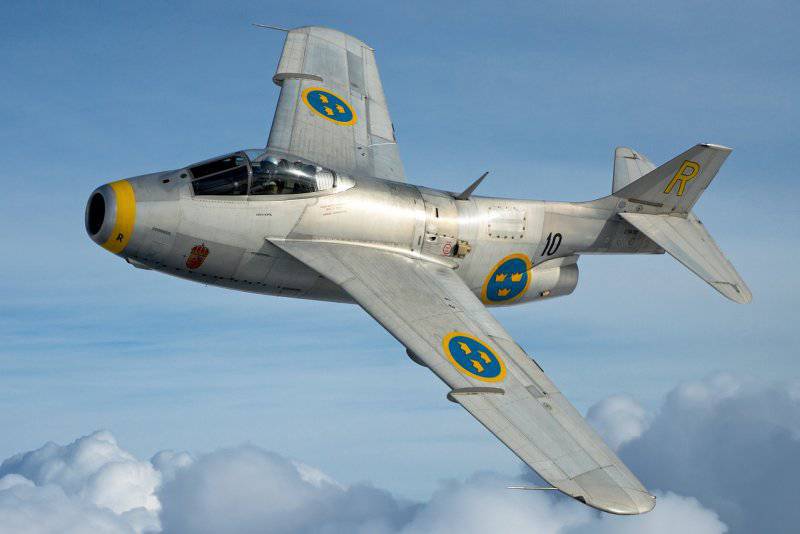
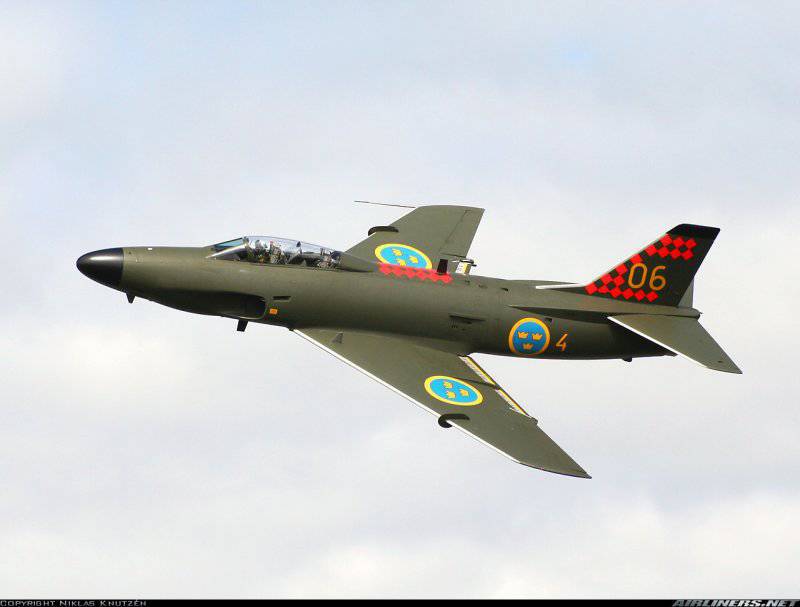
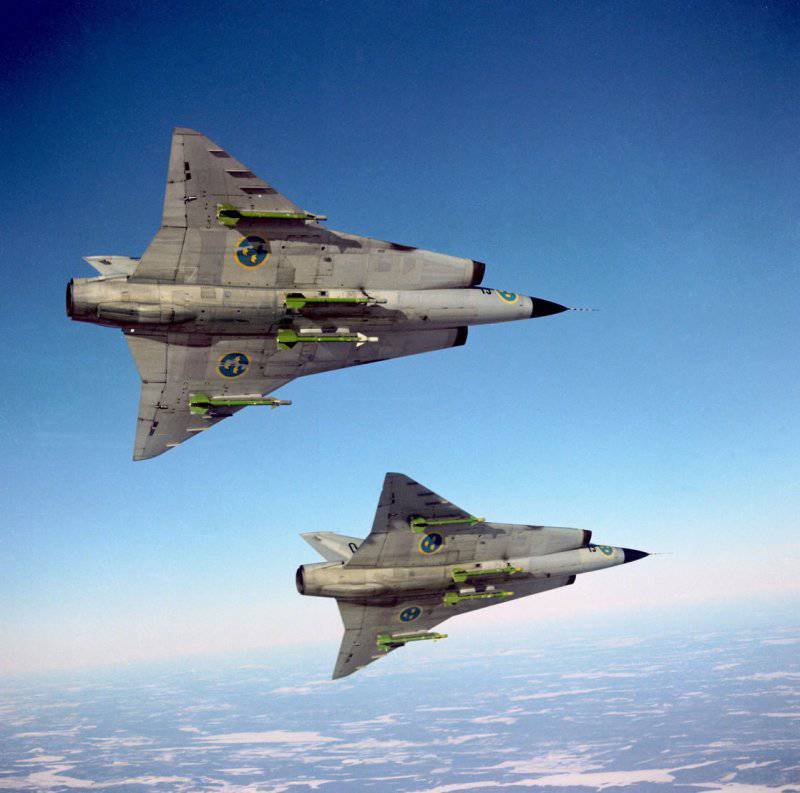
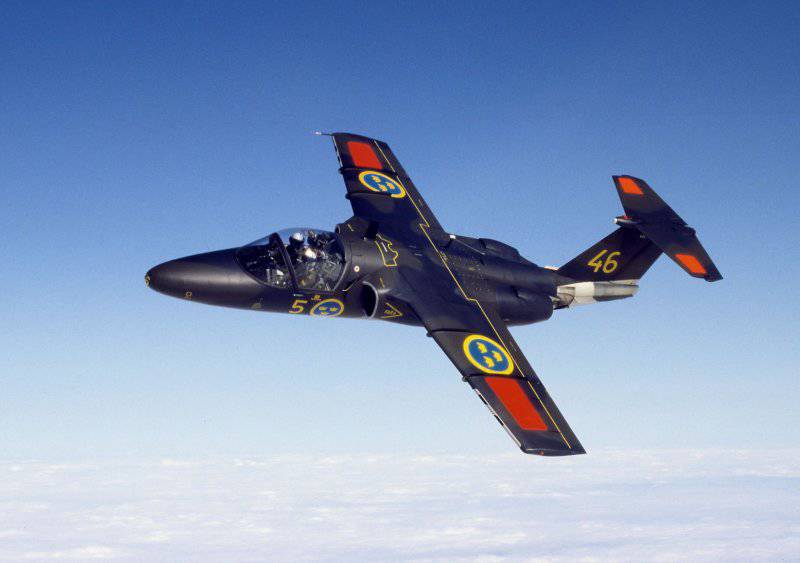
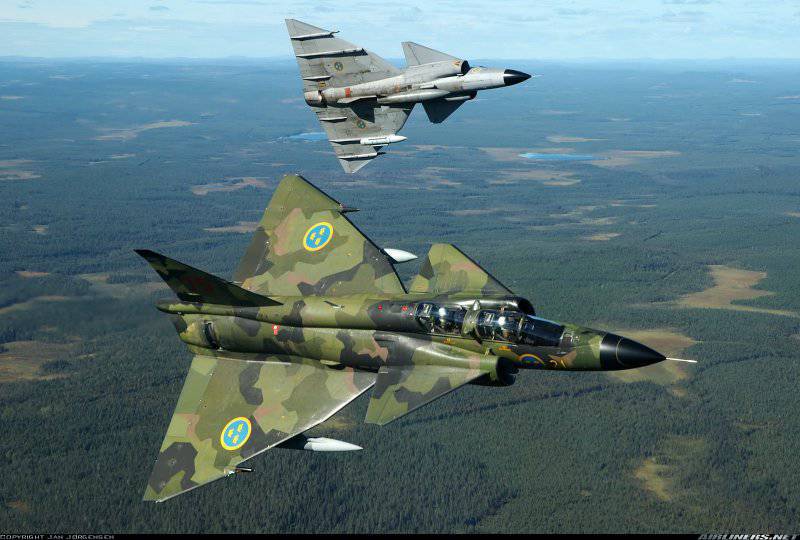
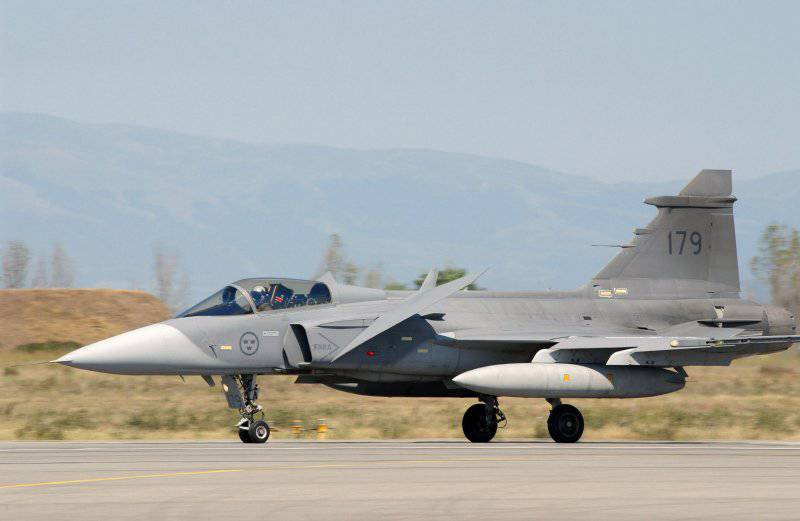
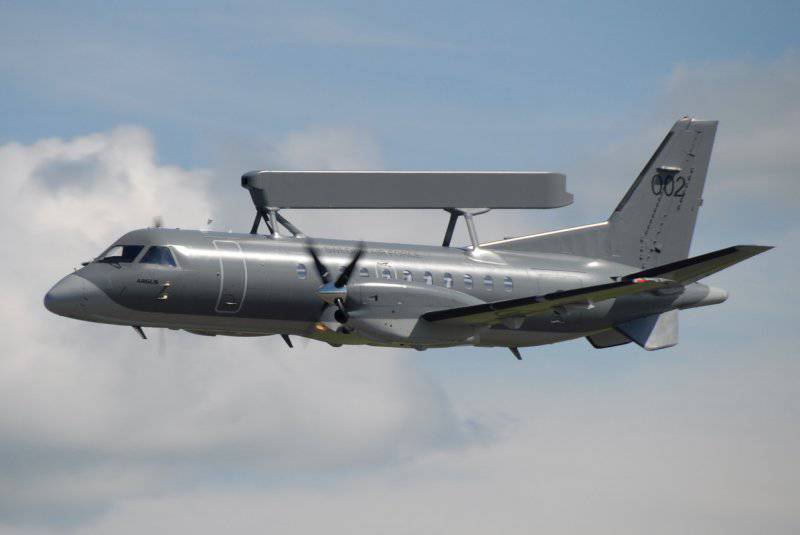
Information